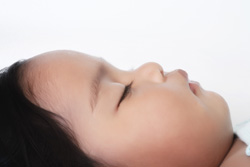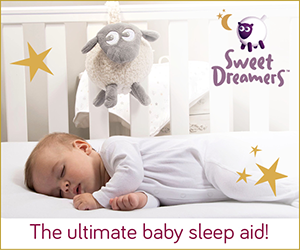General Sleep Safety Tips

The safest place for your baby to sleep is on his or her back in a crib that meet current Canadian safety regulations. Health Canada recommends room sharing for the first six months of your baby’s life.
Babies and young children should never be placed to sleep on standard beds, water beds, air mattresses, couches, futons or armchairs. A baby can suffocate when sleeping on these unsafe surfaces.
Health Canada has received reports of injuries and/or deaths related to the improper use of many products. Follow the safety tips provided to reduce the risk of injury or death related to the use of these products.
• Put your baby on his or her back to sleep, both at nap time and at bedtime.
• Your baby’s crib should be completely empty, except for the crib’s mattress and fitted sheet.
• Avoid the use of loose bedding or soft objects in your baby’s sleeping area. Products like these can be suffocation hazards and should not be placed where your baby sleeps:
– comforters, heavy blankets and quilts
– infant or adult pillows
– foam padding
– stuffed toys
– bumper pads
– sleep positioners
• Blankets can be dangerous if a baby’s head gets covered when he or she sleeps and may cause suffocation. Instead of a blanket, consider dressing your baby in light sleep clothing, like a one-piece sleeper. If a blanket is needed, infants are safest with a thin, lightweight and breathable blanket.
• Overheating is a risk factor for Sudden Infant Death Syndrome (SIDS). If the room temperature is comfortable for you, it is also comfortable for your baby.
• Keep your home completely smoke free. Cigarette smoke is harmful to babies and increases the risk of SIDS. No one should smoke near your baby.
• It is not safe for a baby to sleep unattended or for long periods of time in products such as strollers, car seats, swings, bouncers, slings or baby carriers, that keep him or her in a seated or semi-reclined position. Move your baby to a crib, cradle or bassinet for naps or overnight sleep, or once you have reached your destination.
• Cords on window blinds, shades and curtains are a strangulation hazard. Tie the cords out of your child’s reach or install a tension device for looped cords. Whether the blind is up or down, make sure your child cannot reach the cords.
• Place your baby’s sleeping area so that hazards like windows, patio doors, lamps, candles, electrical plugs, corded baby monitors, extension cords and small objects are out of your child’s reach.
• Not everyone will take the same care you do in making sure their home is safe for children. When visiting family and friends, scan your surroundings for potential hazards and supervise your children closely.
• Check regularly for recalls of children’s toys, clothing, furniture and equipment by contacting the manufacturer or by visiting Healthy Canadians’ Recalls and Safety Alerts web page: healthycanadians.gc.ca/recall-alert-rappel-avis/index-eng.php.
Information courtesy of Health Canada.




